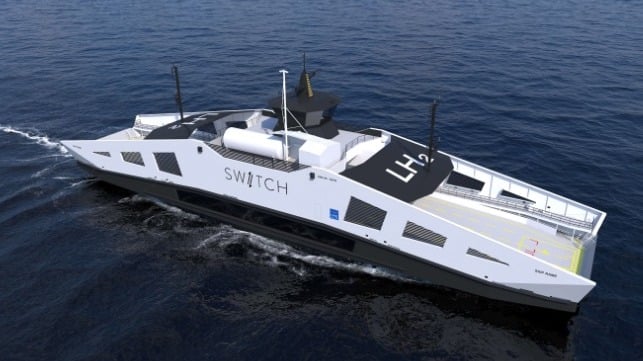Effort to Develop First U.S. Liquid Hydrogen-Fueled RoPax Ferry

An effort is underway to leverage the cutting-edge technology for hydrogen-fueled vessels to develop the first RoPax vehicle ferry in the U.S. to be fueled by liquid hydrogen. SWITCH Maritime, the U.S. shipowner that launched the first hydrogen-powered ferry in the U.S. is in collaboration with LH2 Shipping and LMG Marin in Norway to commence construction in the U.S. of a hydrogen-fueled RoPax ferry.
SWITCH’s first hydrogen-powered vessel, the Sea Change, is a 75-passenger catamaran ferry featuring 600 kW of electric motor propulsion, powered by 360 kW of fuel cells with 246 kilograms of gaseous H2 (GH2) storage at 250 bar pressure. The Sea Change started public passenger service as part of the San Francisco Bay Ferry system in July 2024, after receiving its final Certificate of Inspection (COI) from the U.S. Coast Guard in May 2024.
“With rigorous planning, state-of-the-art engineering, and support from leading industry partners and the U.S. Coast Guard, we are ready to pioneer zero-carbon LH2 fueling for heavier, higher-horsepower workboats,” explains Pace Ralli, Founder & CEO of SWITCH.
They plan to develop a vessel using the designs from LMG Marin for an 80-car, 300-passenger RoPax vehicle ferry. The design is already DNV classed and is being successfully operated by Norled. Named MF Hydra, the ferry performs a triangular six nautical mile round-trip fueled with liquid hydrogen (LH2). The companies highlight it has a four-tonne LH2 tank (about the size of a 40-foot container) that fits easily on the top deck and receives fuel from an LH2 truck via a bunkering system using over-pressure in the truck to push the liquid to the ship. To date, MF Hydra has successfully received LH2 fuel approximately 50 times since starting hydrogen-powered operations in March 2023.
The RoPax vehicle ferry will have a service speed of 14 knots and is expected to require fueling only once per week (volume of 3000 kilograms from one LH2 truck) in a typical operation, with no requirement for shoreside electric charging infrastructure. While the design will require some further adapting to meet USCG requirements, SWITCH notes the larger steel hull of the vehicle ferry offers more flexibility in terms of space and weight compared to aluminum catamaran fast ferry designs, making it an ideal platform for introducing LH2 fueling in the U.S. The LH2 from the cryogenic storage tanks is vaporized onboard and used in the PEM fuel cells to create electricity for the electric motors. Like the GH2 fast ferries, the vessel’s only emissions will be pure H20 vapor, with zero carbon or other diesel-related emissions.
In addition to the Sea Change, SWITCH is also working on a 150-passenger, 25-knot catamaran to build for the SF Bay Ferry service, using the same gaseous H2 (GH2) storage and fuel cell equipment as the first vessel (to be revealed in Q1 2025). When designing larger zero-emissions harbor craft such as 300+ passenger ferries, vehicle ferries, and harbor tugs, SWITCH plans to transition from gaseous storage to cryogenic liquid H2.
SWITCH has focused on hydrogen for its potential to serve as a viable option highlighting its belief that other battery-only solutions fall short due to space and weight constraints. The company notes that generally, hydrogen as a fuel source can support greater range and power requirements due to its high energy density. Additionally, it simplifies zero-emissions vessel operations by eliminating the need for fixed shoreside charging infrastructure, allowing for fueling through established truck-to-ship or ship-to-ship practices. Compressed GH2 SWITCH says is well suited for small- to medium-sized vessels; however, as vessel size and energy demand increase, cryogenic LH2 becomes the preferred storage solution. Similar to Liquefied Natural Gas (LNG), cryogenic LH2 supports faster refueling speeds for large volumes (e.g. tons per hour).
